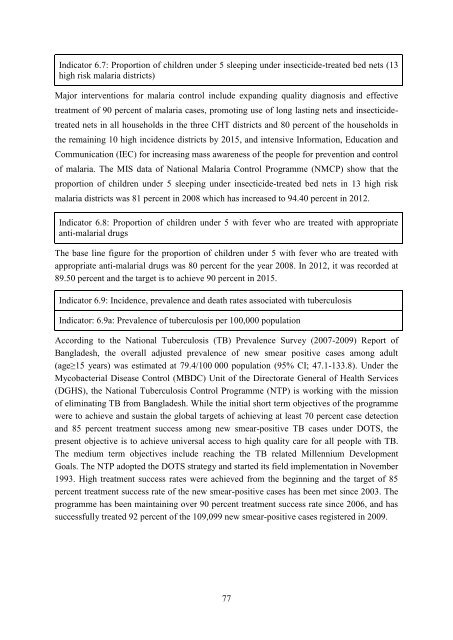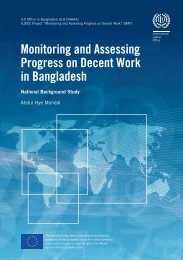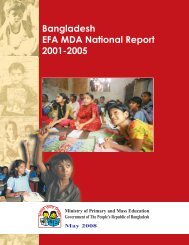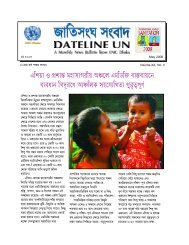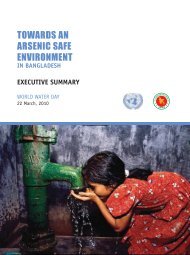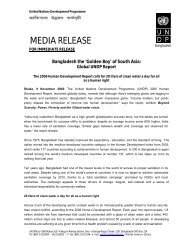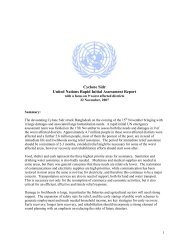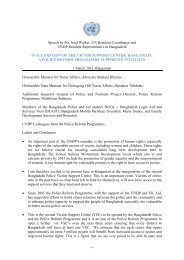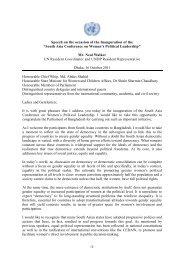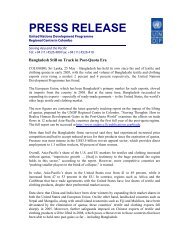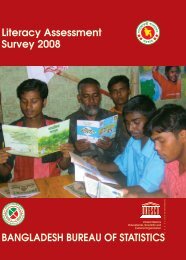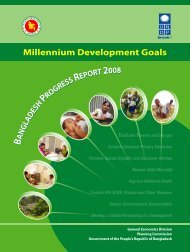MDG Report 2012 - United Nations in Bangladesh
MDG Report 2012 - United Nations in Bangladesh
MDG Report 2012 - United Nations in Bangladesh
- No tags were found...
You also want an ePaper? Increase the reach of your titles
YUMPU automatically turns print PDFs into web optimized ePapers that Google loves.
Indicator 6.7: Proportion of children under 5 sleep<strong>in</strong>g under <strong>in</strong>secticide-treated bed nets (13high risk malaria districts)Major <strong>in</strong>terventions for malaria control <strong>in</strong>clude expand<strong>in</strong>g quality diagnosis and effectivetreatment of 90 percent of malaria cases, promot<strong>in</strong>g use of long last<strong>in</strong>g nets and <strong>in</strong>secticidetreatednets <strong>in</strong> all households <strong>in</strong> the three CHT districts and 80 percent of the households <strong>in</strong>the rema<strong>in</strong><strong>in</strong>g 10 high <strong>in</strong>cidence districts by 2015, and <strong>in</strong>tensive Information, Education andCommunication (IEC) for <strong>in</strong>creas<strong>in</strong>g mass awareness of the people for prevention and controlof malaria. The MIS data of National Malaria Control Programme (NMCP) show that theproportion of children under 5 sleep<strong>in</strong>g under <strong>in</strong>secticide-treated bed nets <strong>in</strong> 13 high riskmalaria districts was 81 percent <strong>in</strong> 2008 which has <strong>in</strong>creased to 94.40 percent <strong>in</strong> <strong>2012</strong>.Indicator 6.8: Proportion of children under 5 with fever who are treated with appropriateanti-malarial drugsThe base l<strong>in</strong>e figure for the proportion of children under 5 with fever who are treated withappropriate anti-malarial drugs was 80 percent for the year 2008. In <strong>2012</strong>, it was recorded at89.50 percent and the target is to achieve 90 percent <strong>in</strong> 2015.Indicator 6.9: Incidence, prevalence and death rates associated with tuberculosisIndicator: 6.9a: Prevalence of tuberculosis per 100,000 populationAccord<strong>in</strong>g to the National Tuberculosis (TB) Prevalence Survey (2007-2009) <strong>Report</strong> of<strong>Bangladesh</strong>, the overall adjusted prevalence of new smear positive cases among adult(age≥15 years) was estimated at 79.4/100 000 population (95% CI; 47.1-133.8). Under theMycobacterial Disease Control (MBDC) Unit of the Directorate General of Health Services(DGHS), the National Tuberculosis Control Programme (NTP) is work<strong>in</strong>g with the missionof elim<strong>in</strong>at<strong>in</strong>g TB from <strong>Bangladesh</strong>. While the <strong>in</strong>itial short term objectives of the programmewere to achieve and susta<strong>in</strong> the global targets of achiev<strong>in</strong>g at least 70 percent case detectionand 85 percent treatment success among new smear-positive TB cases under DOTS, thepresent objective is to achieve universal access to high quality care for all people with TB.The medium term objectives <strong>in</strong>clude reach<strong>in</strong>g the TB related Millennium DevelopmentGoals. The NTP adopted the DOTS strategy and started its field implementation <strong>in</strong> November1993. High treatment success rates were achieved from the beg<strong>in</strong>n<strong>in</strong>g and the target of 85percent treatment success rate of the new smear-positive cases has been met s<strong>in</strong>ce 2003. Theprogramme has been ma<strong>in</strong>ta<strong>in</strong><strong>in</strong>g over 90 percent treatment success rate s<strong>in</strong>ce 2006, and hassuccessfully treated 92 percent of the 109,099 new smear-positive cases registered <strong>in</strong> 2009.77


